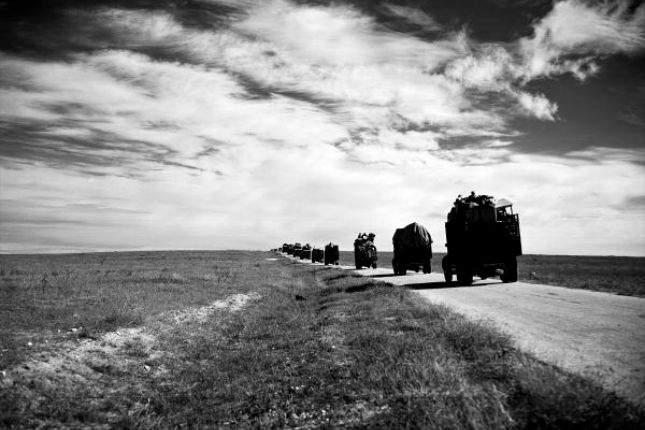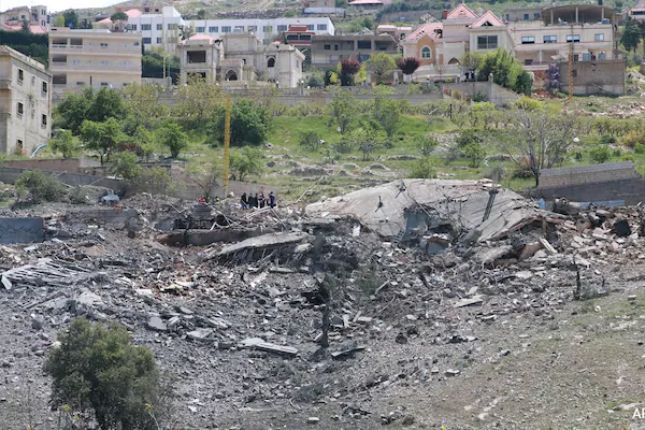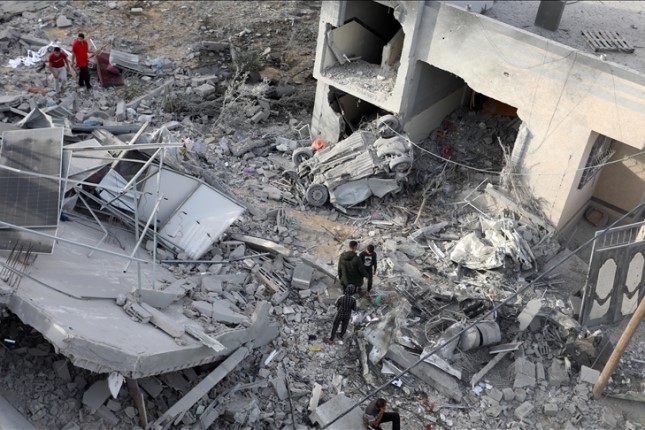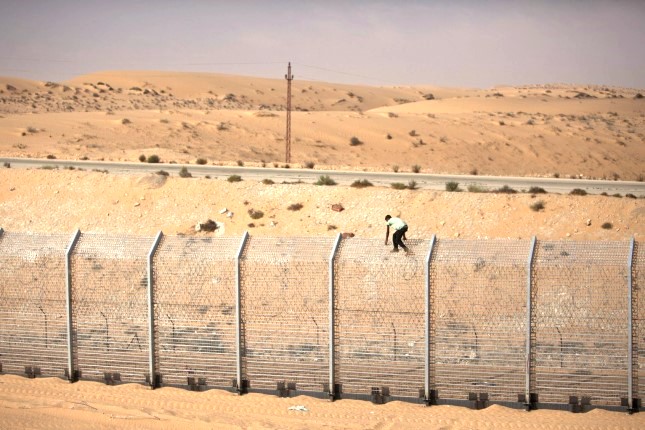Donald Trump’s absurd, immoral and flagrantly illegal plans to acquire the Gaza Strip and expel its inhabitants has incited rage and disbelief around the world, but his unhinged gambit has its origin eight decades ago in the disastrous U.N. plan to partition Palestine — a plan that ignited the first mass ethnic cleansing of the Palestinian people.
On June 16, 1947, members of the United Nations Special Committee on Palestine (UNSCOP) representing 11 countries arrived in Jerusalem. Their mission was to investigate the causes of the Palestinian conflict and make recommendations about the future of the country as the British Mandate of Palestine came to an end.
From the outset, the investigation was grossly biased in favor of Palestine’s Jewish minority. No representatives of Arab nations were on UNSCOP and the U.N. General Assembly preemptively rejected Arab calls for a single Palestinian state guaranteeing civil and religious rights for Arabs and Jews.
As Israeli historian Ilan Pappé points out, the Arabs simply “demanded that Palestine be treated the same as all its neighbouring Arab countries, which had obtained full independence once their respective [British] mandates had ended.” A Very Short History of the Israel–Palestine Conflict (p.46).
Instead, the committee heard from 31 Jewish leaders from 17 Zionist organizations compared to only six representatives from Arab countries, to consider the partitioning of Palestine into separate Jewish and Arab states — something it had no legal authority to do under Article 1 (2) of the U.N. Charter which enshrines “the principles of equal rights and self-determination of all peoples.”
It was a disastrous decision for Arabs, Jews and the entire region — one that would result in mass ethnic cleansing, stark inequality, perpetual fear and genocidal war.
When they arrived in Tel Aviv, UNSCOP members were received by an elated throng of residents. Zionist leaders had declared a public holiday; cheering crowds filled the streets lined with flowers and Star of David flags; committee members were swarmed by friendly locals. At City Hall, the mayor ushered the group onto the balcony as the crowd below burst into the Jewish anthem Hatikvah celebrating the biblical prophecy of the Jews’ return to the Holy Land.
Behind the scenes, everything was carefully stage-managed. During their seven-day visit, UNSCOP members were taken on tours of Jewish industry and commerce, agricultural settlements, medical centers, universities, laboratories and scientific institutes — all accompanied by top Jewish Agency officials including future Deputy Prime Minister Abba Eban.
At each location, the planners made sure that committee members “coincidentally” encountered Jewish settlers from their own countries who extolled the Zionist project.
To convince UNSCOP officials that the nascent Jewish state could repel any Arab attack, clandestine meetings were set up with leaders of Jewish underground militias. Included in the meetings were the right-wing Zionist guerilla group, the Irgun, and the high command of the main paramilitary and intelligence group, the Haganah.
Haganah Spying
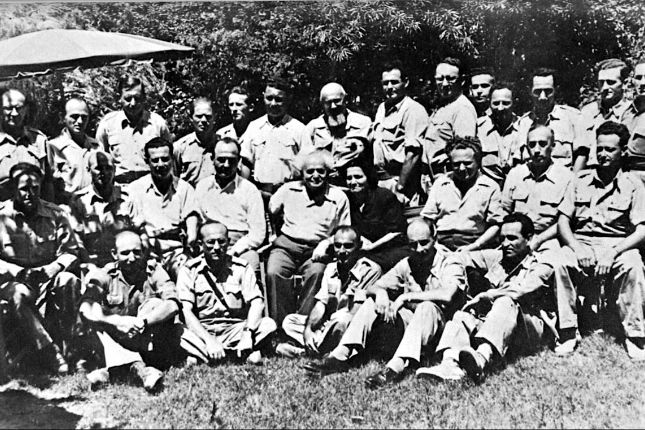
Haganah high command on the eve of the creation of the Israeli Defense Forces, or IDF, June 1948. (Wikimedia Commons, Public domain)
What the committee members didn’t know was that the Haganah was also spying on all their private conversations.
“Microphones were placed in hotel and conference rooms. All phone conversations were tapped,” writes Israeli investigative journalist Ronan Bergman. “The cleaning staff in the building in Jerusalem where the committee held daily hearings was replaced by female agents who reported back each day on its activities.”
Two UNSCOP members, from Uruguay and Guatemala, were allegedly bribed to provide inside information about confidential committee deliberations. The Guatemalan representative was also suspected of leaking inside information to a Jewish Agency official.
At the end of each day, the intelligence briefs (code-named Delphi Report with the inscription “Read and Destroy”) were circulated among the Jewish officials to help them prepare for questions that might be asked when they testified before the committee.
Among those giving testimony to the committee was future Prime Minister David Ben Gurion who eloquently invoked Jewish exceptionalism and their biblical claim to the land.
“Although it was [the Jewish people’s] bitter destiny to wander in exile for many centuries it always remained attached with all its heart and soul to its historic homeland,” Ben-Gurion intoned. “No individual Jew can be really free, secure and equal anywhere in the world as long as the Jewish people as a people is not again rooted in its own country and as an equal and independent nation.”
Meanwhile, future Israeli President Moshe Shertok (untruthfully) told the committee that Jewish immigration to Palestine had not displaced the Arab population and, incredibly, that, “It was not easy to find any instance in the history of colonization where a large-scale settlement scheme had been conducted with so much respect for the interests of the existing population.”
”The entire Zionist case was outrageous. Its arguments were spurious, prejudiced and hypocritical to the extreme,” writes Jeremy R. Hammond in The Rejection of Palestinian Self-Determination. “And yet UNSCOP took them quite seriously. It accepted the argument that to allow democracy in Palestine ‘would in fact destroy the Jewish National Home’ and on that basis explicitly rejected the right to self-determination of the Arab majority.”
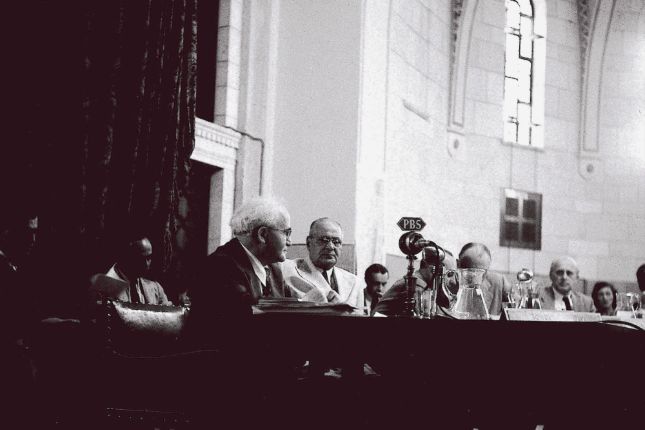
Ben-Gurion, left, at UNSCOP meeting at YMCA in Jerusalem, July 4, 1947. (Hans Pinn, the National Photo Collection of Israel, Government Press Office Public domain)
On Aug. 8, 1947, UNSCOP left Palestine to tour the Displaced Persons (DP) Camps for Jewish wartime refugees in Austria and Germany.
Despite objections from a few of the committee members that it would be “improper to connect the displaced persons, and the Jewish problem as a whole, with the problem of Palestine,” more time was spent in visiting the DP camps than visiting Palestine’s Arab neighbours.
New York Times editor Arthur Ochs Sulzberger, a prominent American Jew, was outraged by the Zionists’ weaponization of the plight of Jewish refugees in Europe’s DP camps. “We in the United States should open our doors to persons of all faiths and creeds,” he said in a speech reported in his paper.
“France,” he said, “seeks new citizens and they are at her door clamoring for entry. England, historic refuge for oppressed nationals, can take its share. Admitting that the Jews of Europe have suffered beyond expression, why in God’s name should the fate of all these unhappy people be subordinated to the single cry of statehood?”
The objections fell on deaf ears — Europe and the U.S. were soon to abandon all responsibility for their Jewish refugees and the future of the Arab majority in Palestine.
Two-State Plan
On Sept. 3, 1947, UNSCOP proposed a Plan of Partition of Palestine into two independent states — one Jewish and one Arab — with Jerusalem placed under the control of a “special international regime.” The plan was supported by seven of the 11 members, with Iran, India and Yugoslavia voting against it, and Australia abstaining.
By any standards, the proposal was grossly unjust: Jews, who made up roughly a third of the total population in Palestine (630,000 people) were given 56 percent of the land that included the most arable areas and most of the coastline. Arab Palestinians who made up roughly two-thirds majority (1,324,000 people) received only 42 percent of the territory.
The UNSCOP proposal would next go to a critical vote in the U.N. General Assembly for which the Zionists’ had been preparing with a massive global lobbying campaign funded by a million dollars from the Jewish Agency, the de facto Jewish government in Palestine, according to historian Tom Segev in One Palestine Complete (p.496).
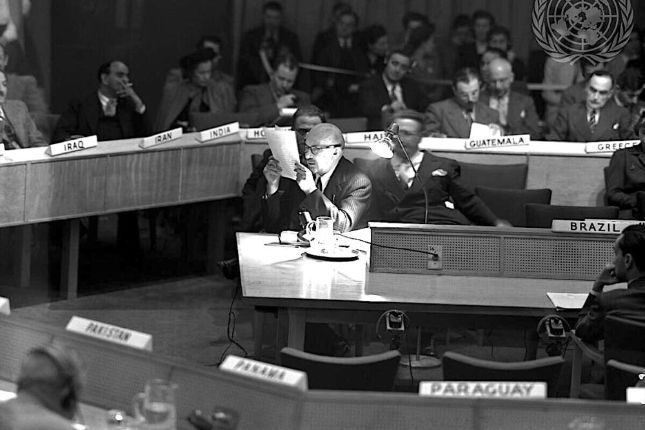
Chaim Weizmann, former president of the Jewish Agency for Palestine, sums up the Zionist views before the United Nations Ad Hoc Committee on the Palestinian Question, Oct. 18, 1947. (UN Photo/Kari Berggrav)
Their strong-arming tactics began in the White House where they told Democratic President Harry Truman that if he failed to support the partition plan, his party, which received a large number of Jewish contributions, would suffer serious consequences.
“I do not think I ever had as much pressure and propaganda aimed at the White House as I had in this instance,” Truman is quoted as saying in American Presidents and the Middle East by George Lenczowski (p. 157). “The persistence of a few of the extreme Zionist leaders — actuated by political motives and engaging in political threats — disturbed and annoyed me.”
But despite Truman’s resentment of the lobby and its “unwarranted influence,” the U.S. ultimately fell in line. On Oct. 11, 1947, the Americans made a formal declaration in favor of partition.
The U.S., then, at the Zionists’ bidding, began conscripting smaller countries with bribes and threats: Liberia and Nicaragua were warned that they would face severe sanctions if they did not vote for partition; 26 U.S. senators in control of U.S. foreign aid sent a telegram to wavering countries “urging” their support for the partition plan; Supreme Court justices Felix Frankfurter and Frank Murphy warned Philippine President Manuel Roxas that a vote against the partition plan would alienate millions of Americans.
Nehru Objects
Infuriated by these tactics, Indian Prime Minister Jawaharlal Nehru revealed that the Zionists had tried to bribe his country with millions of dollars and that his sister, Vijaya Lakshmi Pandit, the Indian ambassador to the U.N., had been warned that her life was in danger unless “she voted right.”
On Nov. 26, 1947, the Partition Plan was put to a vote in the 57-member General Assembly chamber where it looked like it would fall short of the two-thirds majority required to pass.
Refusing to accept defeat, the Zionists filibustered the session, managing to postpone the vote by three days – enough time to pull out all stops for a final lobbying blitz.
When the General Assembly finally voted on Nov. 29, the Partition Plan (UNGA Resolution 181) was narrowly passed by two votes. Had the vote been held on the original date it may well have failed to pass and history might have taken a different turn.
It is important to recognize, however, that although the Zionists’ Mafia-style tactics succeeded in achieving partition, Resolution 181 was non-binding and only a recommendation that was never endorsed by the Security Council.
Additionally, the United Nations had no authority under its own Charter to partition Palestine; Resolution 181 was in direct contravention of Article 1 (2) and Article 55 of the Charter that call for the “principle of equal rights and self-determination of peoples.”
Egyptian diplomat Nebil Elaraby wrote: “The legitimate aspirations and the high hopes of the whole Arab nation were consequently shattered when they saw with deep sorrow that the United Nations, the supposed conscience of mankind, had reached biased conclusions that brought grievous damage to the cause of justice and international morality. The law of the Charter was sacrificed for the convenience of political expediency.”
To this day, there remains a misconception that the United Nations created a Jewish state which it had no authority to do.
Instead, Resolution 181 gave a green light to the Zionist paramilitary militias — the Haganah, the Stern Gang and the Irgun — to lay claim to a Jewish state in Palestine through a violent ethnic cleansing campaign that immediately followed the U.N. resolution.
Called Plan Dalet (D), what happened next is chillingly described by Pappé: “The orders came with a detailed description of the methods to be used to forcibly evict the people: large-scale intimidation; laying siege to and bombarding villages and population centers; setting fire to homes, properties, and goods; expelling residents; demolishing homes; and, finally, planting mines in the rubble to prevent the expelled inhabitants from returning…”
When it was over, more than 750,000 Palestinians had been uprooted; 531 villages had been destroyed; 70 civilian massacres had taken place and an estimated 10-15,000 Palestinians were dead.
“The international community, all signed up to a charter committed to the rule of law, justice and equal rights for nations, had cleared the way for catastrophe,” writes Pappé in A Very Short History (p.58) “— a catastrophe so all-encompassing it became the very definition of the Arabic word: Nakba.”
From its inception, Resolution 181 was a disastrous plan with cataclysmic consequences for the future of Palestinians, Jews, the region and the world.
It allowed Europe and the U.S. to abandon their Jewish refugees in the aftermath of the Holocaust; it gave the go-ahead to the Zionists to create a theocratic apartheid state on land of Palestine’s indigenous people.
And it has enabled Israel to flagrantly violate international law with its ongoing occupation of territory seized in the 1967 war, illegal settlements on the West Bank, multiple war crimes, crimes against humanity and genocide in Gaza today.
Despite its history of lawlessness, we are constantly told that Israel has a sacrosanct right to exist. However, “the idea of a state’s inherent ‘right to exist’ is fallacious,” writes former U.N. official Moncef Khane. “Conceptually or legally, no such natural or legal right exists for Israel or any other state [under] international law.”
What international law does say, Khane tells us, is that “peoples have an inalienable right to self-determination” and that “an occupying power has no inherent right of self-defence against the people it subjugates, but the people under occupation have an inherent right of self-defence against their occupiers.”
Trump’s insane and criminal gambit to take over Gaza contravenes all these rights and violates every major international statute and treaty.
Forced deportation is a war crime and a crime against humanity prohibited by the Geneva Convention and the Nuremberg Tribunal; denying Palestinians the right to return to their land is in violation of the International Covenant on Civil and Political Rights; seizure of Palestinian territory is land theft pure and simple.
Needless to say, Israel has violated all these laws from the time of the Nakba, but Palestinians, who have sacrificed everything and suffered immeasurably, have made one thing clear: as they’ve made the long march back to north Gaza devastated by the Israeli war machine and U.S. bombs, they continue to resist any attempt to grab their land and appear determined to never surrender their inalienable right to self-determination.
Main photo: Convey of trucks and cars led by white U.N. jeeps travel through Gaza desert carrying Arab refugees from Gaza to Hebron, Transjordan, for repatriation, Dec. 13, 1949 © UN Photo.
Source: Consortium News.
